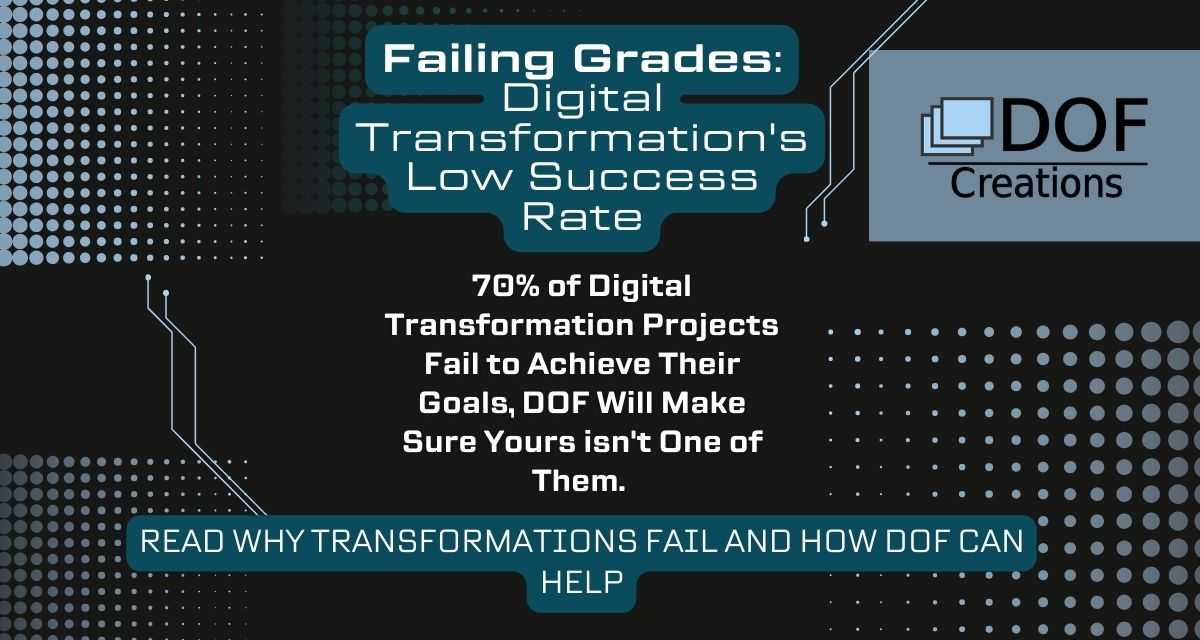A study by McKinsey & Company found that more than 70% of digital transformation projects fail to achieve their goals, meaning a lowly 30% of these projects end up both complete and successful. If you saw a 30% on your report card as a kid, you’d most likely hide it (or maybe try to turn that 3 into an 8 and hope your parents didn’t notice).
While it’s difficult to estimate the exact percentage of digital transformation efforts globally that fail (as success rates can vary depending on a number of factors such as industry, company size, and the specific goals of the transformation project), various studies suggest that the failure rate for digital transformation projects can be quite high.
It’s worth noting that failure in digital transformation projects can take on different forms. Some projects may completely fail to achieve their intended goals, while others may experience delays, cost overruns, or have a limited impact on the organization. Ultimately, the success of digital transformation projects depends on a variety of factors, including the organization’s willingness to invest in the right technology, access to the right personnel, the right management (for the project specifically and within the organization generally), and the ability to adapt to changing industry and end user demands.
Some reasons why digital transformation projects fail are a:
- Lack of clear strategy and goals: Many organizations embark on digital transformation without a clear strategy, singular definition of what digital transformation means to them and their organization, or specific goals in mind, leading to confusion and a lack of focus in their efforts.
- Resistance to change: If internal stakeholders become barriers to progress, their resistance to change can mean the difference between success and failure. Their unwillingness to change can create resistance to new technologies or ways of working, leading to poor adoption and lack of success.
- Lack of skilled personnel: Digital transformation projects require a team with a diverse set of skills, including technical, strategic, and creative expertise. If an organization doesn’t have the right personnel in place, it can be difficult to successfully execute the project.
- This is a particularly common concern as IT professionals are in short supply. And for those who can find skilled technology staffers, finding a way to retain them is a major issue as competition from employers in regard to compensation and other benefits is constantly pulling people to and from many IT teams.
- Poor project management: Effective project management is essential for the success of digital transformation projects. Without clear timelines, milestones, and objectives, projects can easily become unfocused and miss their targets.
- Inadequate technology infrastructure: A digital transformation project may require significant upgrades to an organization’s technology infrastructure, including hardware, software, and network resources. If an organization’s infrastructure is outdated or inadequate, it can be difficult to achieve the desired outcomes.
- It should be noted that outdated technology doesn’t doom a transformation project to failure. The challenge is often, will this entity take the time to slowly evolve critical resources so that they are ready to be a part of a larger transformation project
- Consider cloud adoption efforts where an organization has decided to Lift and Shift multiple applications into a cloud environment without ensuring they’re cloud ready.
- These applications may work generally, but without being “Cloud Ready” this organization will fail to take advantage of the many benefits of flexibility and innovative solutions that the cloud has to offer.
- This organization has forced growth on itself without making sure the growth they hoped for fit them properly.
- Lack of data insights: Digital transformation often involves using data to drive decision-making and gain insights into customer behavior and business performance. Without the right data and analytics tools in place, it can be difficult to make informed decisions and measure the success of the project.
- Unrealistic expectations: Digital transformation projects can be complex and time-consuming, and it’s important to set realistic expectations about what can be achieved and when. If an organization sets unrealistic expectations, it can create frustration and disappointment when the project doesn’t deliver as expected.
As organizations increase their use of the cloud or cloud-based tools, implement dynamic network, security, or other adaptive automation tools, and work to be modern in their thought and approach, digital transformation is often seen as one-size-fits-all strategy. Digital transformation can many things to many organizations, and the path from Point A to Point B will be different for everyone.
While your process and journey through digital transformation is entirely unique to you, we’d like to help and believe the work we’ve done to support others can help you to be a well-tested blueprint or, at least, give you a few ideas so you don’t need to start from scratch.
Ask us how digital transformation can help and how to make it fit your organization’s goals.



